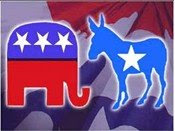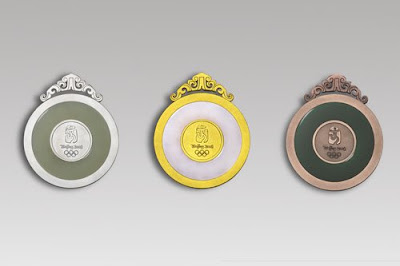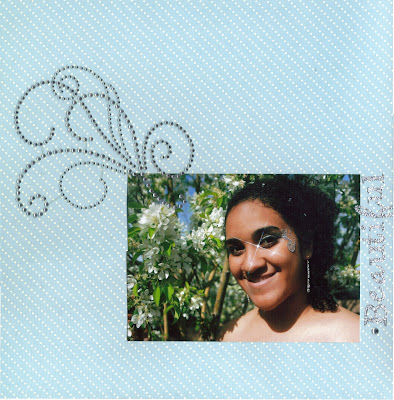You Are a Realist |
You don't see the glass as half empty or half full. You see what's exactly in the glass. You never try to make a bad situation seem better than it is... But you also never sabotage any good things you have going on. You are brutally honest in your assessments of situations - and this always seems to help you cope. |
Sunday, August 31, 2008
* Gigi graduated (this started the summer off). We celebrated with her and her friends on graduation day and then spent the next few weekends attending graduation parties. We ended with her party.
* Gigi turned 18!
* Boo turned 21!
* We went to South Dakota for the 4th and spent a great weekend with family. It was a fun road trip and we were able to see "fireflies".
* Aunt Ether Mae came to town for training and we had a yummy dinner with her and Grandma and Grandpa Burgess.
* Boo went on her first trip solo!!! To Vegas and California!
* Gigi started driving (my heart is still recovering from the last "drive").
* Hunny bunny and I celebrated our 22nd anniversary.
* We took Boo to Las Vegas for her 21st birthday.
* We went on our first vacation without Gigi (she opted to stay home...*sighy*).
* We enjoyed Disneyland and Californialand. Fun Stuff!!!
* 2008 Summer Olympics!
* I went fishing for the 1st time with my team at work (Harry rocked!!!).
There was so much more but these were a few of our highlights!! Wow!!! The summer of 2008 was very eventful!!!!
Saturday, August 30, 2008
another year older and another year wiser (??). The truth is I do feel wiser and with 2 incredible daughters wisdom is a blessing! So I am thankful for the wisdom that comes with (gasp...i am going to say it...)...age!!!! (teeehehehehe...maybe there is hope for me!!)
Friday, August 29, 2008

Thursday, August 28, 2008
I returned to work last night after my vacation and wow!!! Catching up with emails took at least 1.5 hours (and I still have a few I have to deal with). I found out some other things and well...it was not a good day! It was so bad i developed a migraine!!! yucko!!! I hate those. You want to take your eye out and let it rest and you can't. YUCKO!!!! I did get some good news...I was able to get the shift I wanted so in less than a month I will be back on days!!! Wow! How will I handle this!!
Well...off for more...teeehehehehehehe
Tuesday, August 26, 2008
One of the things I was sad about was not being able to watch all of the Olympics. We saw a few things when we were gone but most of the track was lost and one of my favorites...synchronized swimming was not watched at all (sighy). I did get to see the water polo, volleyball (mens) and rythmic gymnastics. And the ending ceremonies...wow!! It was a great show. Now we have to wait 4 more years...and who knows maybe we will see some of it in person...hmmmmmm???? London...we plan to visit there and what better time? hmmmmmmmm?? Over all we did pretty good inthe medal standings (2nd behind China)...
Medal standing
Gold...........36
Silver.........38
Bronze.......38
Great Job America!!!!
Wednesday, August 13, 2008
Well, my team is having a pot luck tonight so i had to make enchiladas (long story of why i am making them when i started out bringing pop...). I love enchiladas!! Yummy...but they are a pain (a huge pain!!) to cook!! and add hot weather!! *SIGHY* The good thing is they are done and I can relax for a few hours (2 more nights until vacation!!...wahoo!!).

The Olympic rings
"These five rings -- blue, yellow, black, green and red -- represent the five parts of the world now encompassed by Olympism and ready to compete against each other. Moreover, the six colours (including the white background) thus combined represent those of all nations, without exception. The blue and yellow of Sweden, the blue and white of Greece, the French, English, American, German, Belgian, Italian and Hungarian tricolours, the yellow and red of Spain are side by side with the new Brazilian and Australian flags, the old Japan and the new China. It is a true international emblem."
Coubertin (Selected Writings II, p. 460, 1913).
As an image of Olympism, Coubertin thought the rings had deep significance: that of the union between men. He multiplied the image to create a total of five rings. He designed and commissioned the Olympic flag to mark the 20th anniversary of the IOC's founding, on 23rd June 1914 in Paris. Coubertin never said nor wrote that he saw a link between the colours of the rings and the continents. For him, the five rings represented the union of the five continents, but the colours were merely those that appeared in all the different national flags at the time.
-- The results of a survey carried out in six countries (Australia, Germany, India, Japan, Great Britain and the USA) in 1995 showed that 92% of those questioned correctly identified the Olympic rings, which made them the most-recognised symbol. They were followed by the McDonald's and Shell emblems (88%), Mercedes (74%) and the United Nations (36%). (SRI Sponsorship Research International).
-- 86% of those questioned associated the Olympic rings with the world's greatest sports event: the Olympic Games. (SRI Sponsorship Research International, 1995).
Medal Count
Gold..........10
Silver.........8
Bronze.......11
Tuesday, August 12, 2008

He refused the military career planned for him by his family, as well as renouncing a promising political career. By the age of 24 he had already decided the aim of his life: he would help bring back the noble spirit of France by reforming its old-fashioned and unimaginative education system.
Coubertin, whose father was an artist and mother a musician, was raised in cultivated and aristocratic surroundings. He had always been deeply interested in questions of education. For him, education was the key to the future of society, and he sought the means to make France rise once more after its defeat in the war in 1870.
It was this conviction that led him to announce at the age of 31 that he wanted to revive the Olympic Games.
He made this announcement in a meeting at the Union of French Societies of Athletic Sports (USFSA), for which he was Secretary General. No one really believed him and his statement was greeted with little enthusiasm.
Two years later, in 1896, the first Olympic Games of the modern era were held in Athens. On that occasion Coubertin was elected the second president of the IOC and he remained president until 1925. Due to the 1st World War, Coubertin requested permission to establish the headquarters of the IOC in Lausanne, Switzerland, which was a neutral country.
On 10 April, 1915 the acts ensuring the establishment of the international administrative centre and archives of the modern Olympic movement were signed in the Town Hall of Lausanne.
In 1922, the IOC headquarters and the Museum collections were moved to the Villa Mon Repos in Lausanne and stayed there for the next 46 years.
His definition of Olympism had four principles that were far from a simple sports competition:
To be a religion i.e. to "adhere to an ideal of a higher life, to strive for perfection"; to represent an elite "whose origins are completely egalitarian" and at the same time "chivalry" with its moral qualities; to create a truce "a four-yearly festival of the springtime of mankind"; and to glorify beauty by the "involvement of the philosophic arts in the Games".
It is clear that the concept of the Olympic Games is far from a simple sports competition.
At the age of 69, in 1931, he published his "Olympic Memoirs" in which he emphasized the intellectual and philosophical nature of his enterprise and his wish to "place the role of the IOC, right from the start, very much above that of a simple sports association".
Pierre de Coubertin suddenly died of a heart attack on 2 September, 1937, in a park in Geneva, and thus his "symphony" remained unfinished.
The city of Lausanne had decided to award him honorary citizenship of the city, but he died just prior to the ceremony.
In accordance with Pierre de Coubertin's last wishes, he was buried in Lausanne and his heart was placed inside a stele erected to his memory at Olympia.


Lin Yue and Huo Liang (it looks like you are seeing a double image but in reality they are 2 different people!...amazing!!)

Monday, August 11, 2008



The Olympic Torch
The Beijing Olympic Torch boasts strong Chinese characteristics, and showcases Chinese design and technical capabilities. It embodies the concepts of a Green Olympics, a High-tech Olympics and the People's Olympics.
The Key Facts about the Torch
The torch is 72 centimetres high, weighs 985 grams and is made of aluminium. The torch is of a curved surface form, with etching and anodizing being used during its production. A torch can usually keep burning for approximately 15 minutes in conditions where the flame is 25 to 30 centimetres high in a windless environment. The torch has been produced to withstand winds of up to 65 kilometres per hour and to stay alight in rain up to 50mm an hour. The flame can be identified and photographed in sunshine and areas of extreme brightness. The fuel is propane which is in accordance with environmental guidelines. The material of its form is recyclable.
The Artistic and Technical Features of the Torch
The torch of the Beijing Olympic Games has a very strong Chinese flavour. It demonstrates the artistic and technical level of China. It also conveys the message of a Green Olympics, a High-tech Olympics and the People's Olympics. The shape of the paper scroll and the lucky clouds graphic, expresses the idea of harmony. Its stable burning technique and adaptability to the environment have reached a new technical level. The torch of the Beijing Olympic Games is designed, researched and produced in China. BOCOG owns all intellectual property rights.
The Fuel for the Torch
Under the concept of a Green Olympics, environmental protection was a key element listed in the invitation documents to the design companies, by BOCOG. The fuel of the torch is propane, which is a common fuel which also comes with a low price. It is composed of carbon and hydrogen. No material, except carbon dioxide and water remain after the burning, eliminating any risk of pollution.
The Burning System
Its stable burning technique and adaptability to the environment have reached a new technical level. It can stay alight in severe weather conditions such as strong wind, rain, snow, hail, etc. The flame can also be identified in sunshine and areas of extreme brightness so as to satisfy the requirements of capturing photographic images and video footage.
The Design Timelines
2005 August BOCOG developed the design concepts and requirements of the torch.
2005 December BOCOG recruited potential torch designs from the design society. In total, BOCOG received 388 pieces of works.
2006 June-August BOCOG selected the structural designer and the burning system designer.
2007 January Beijing Olympic Torch was approved by IOC




The Torch Relay lantern will be used to store the Olympic flame. Its main purposes will be to receive the Olympic flame kindled in Olympia, to light the Olympic torch and to exhibit the sacred flame.
The International Olympic Committee (IOC) requires the flame remain lit during the entire course of the Torch Relay in order to protect the sanctity of the Olympic flame and the purity of the Torch Relay. If the torch flame should be extinguished, it must be relit using the mother flame stored in the lantern. This is to ensure that the flame used to light the Olympic cauldron at the Opening Ceremony comes from the sacred Olympic flame kindled in Olympia.
The inspiration for the original design of the Beijing Olympic Torch Relay lantern comes from the traditional lanterns used inside ancient Chinese palaces. The silver luster of the lantern coupled with crystal-clear glass serve as a foil to the flame and communicates the Olympic flame's sanctity and purity.

The Olympic cauldron plays a major role in the Olympic Torch Relay. The lighting of the Olympic cauldron symbolizes the end of the Olympic Torch Relay and the beginning of the Olympic celebration.
The Beijing Olympic cauldron is based on the concept of a "round heaven and square earth" and takes after a typical cauldron from the Chinese Bronze Age. The cauldron shares with the torch and lantern the design element of the "lucky cloud."
The 56 "lucky clouds" hollowed out of the curved plate of the Olympic cauldron symbolize well wishes to the world from the 56 ethnic groups in China. The base of the cauldron has four legs with eight faces, symbolizing that the Beijing Olympic Games welcomes friends from all directions across the world. The Olympic cauldron stands 130 centimeters high, symbolizing the 130-day duration of the Beijing Olympic Torch Relay. The cauldron plate is 29 centimeters deep, symbolizing the 29th Olympiad. The cauldron post is 112 centimeters tall, symbolizing the 112 years that have passed between the staging of the first modern Olympic Games in 1896 and the 2008 Olympic Games.

Medal Update
Sunday, August 10, 2008
Medal Count
Gold........2
Silver......3
Bronze....4
Design of the Medal for the Beijing 2008 Olympic Games
 front of medal
front of medal reverse side of medal
reverse side of medal
The medal for the Beijing 2008 Olympic Games is designed with inspiration coming from "bi", China's ancient jade piece inscribed with a dragon pattern. The medals, made of gold and jade, symbolize nobility and virtue and are the embodiment of traditional Chinese values of ethics and honor, sending forth strong Chinese flavor.
The medals are 70mm in diameter and 6mm in thickness. On the front side, the medal adopts standard design prescribed by the International Olympic Committee. While on the back, the medal is inlaid with jade with the Beijing Games emblem engraved in the metal centerpiece. The design inspiration of the medal hook derives from jade "huang", a ceremonial jade piece with decoration of double dragon pattern and "Pu", the reed mat pattern.
Noble and elegant, the Beijing Olympic Games medal is a blending of traditional Chinese culture and the Olympism. It gives the winners of the Games great honor and acclamation as recognition of their achievement.
Note: bi, a flat jade disc with a circular hole in the center
Huang, a semi circular jade ornament

reverse side of the medal

front of the medal
*all the Summer Olympics information provided has come from the 2008 Summer Olympics official site***
Saturday, August 9, 2008




(1) Showing the rich concept of the Beijing Paralympic Games
Cows, symbolic of a down-to-earth, diligent, staunch and never-say-die spirit, are adopted to show the unremitting spirit of athletes with a disability in being the best they can be. It dovetails with the upbeat spirit of Paralympians and the concept of "Transcendence, Equality, Integration" of the Beijing Paralympic Games.
The determined, optimistic and diligent spirit of cows reflects a positive attitude to life. The Paralympic Games calls for people with a disability to enjoy the same rights to compete in sports as anyone else, and to achieve sporting excellence and inspire and excite the World, and thus develop their strength to add vigor and vitality to social progress.
Fu Niu Lele invites people from across the globe to come to Beijing, enjoy the splendours of the Beijing Paralympic Games and see the inspiring performances of Paralympic athletes who achieve the unexpected
(2) Embodying the harmony between man and nature
As one of the animals closest to human beings, cows are well-known for their friendliness and their affinity to the humans who care for them. Throughout the history of the development of world civilization, poetry and songs have clearly expressed the aspiration of humankind for a harmonious life. Cows have often found their way into the natural, cozy and poetic country life reflected in literary and art works, showing public expectation for the harmonious coexistence between man and nature.
In the traditional culture of China, cows are also depicted as animals considered auspicious in inviting good weather and bumper harvests.
(3) Carrying rich national style and cultural features
The design scheme absorbs the modeling and design styles unique to China's folk engraved prints, New Year drawings, and toys. This, plus features unique to the modeling of modern cartoons, shows an integration of traditional folk style and public interest with that of modern times.
(4) Cows are widely accepted internationally
Cows were one of the first animals depicted in literary and art works. Cases in point include the Lascaux mural in France and Altamira rock paintings in Spain, which all contain drawings of cows. Therefore, adopting cows as the mascot of the Paralympic Games, instead of traditional rare animals, is a creative act in terms of design to a certain extent.
(5) Commanding space for future designs and marketing
Friday, August 8, 2008

Thursday, August 7, 2008

I wish you all the best and may you have a killer season!!! Go Jets!!! Go Favre!!!
"If I had to select one quality, one personal characteristic that I regard as being most highly correlated with success, whatever the field, I would pick the trait of persistence. Determination. The will to endure to the end, to get knocked down seventy times and get up off the floor saying, "Here comes number seventy-one!"
-- Richard M. Devos
 Boo turns 21 at TI in Vegas.
Boo turns 21 at TI in Vegas.


















 Gigi and Nina Lucy and Elena
Gigi and Nina Lucy and Elena




